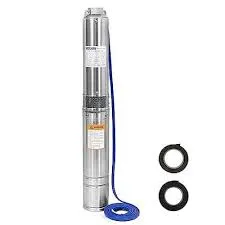Nov . 11, 2024 12:00 Back to list
deep submersible well pump
Deep Submersible Well Pumps An Essential Component in Water Extraction
Deep submersible well pumps are vital devices utilized in the extraction of water from deep aquifers. These pumps are designed to operate underwater, often at depths that can exceed several hundred feet, making them crucial for providing water to agricultural fields, residential areas, and industrial applications. Their unique design and functionality distinguish them from traditional pumps, enabling efficient performance even in challenging conditions.
Design and Functionality
The deep submersible well pump consists of several key components, including a motor, pump bowl assembly, and discharge head. The motor is typically located at the bottom of the pump, submerged in the well water. This submersible design not only allows for quiet operation but also minimizes the risk of cavitation, a phenomenon that can damage pumps and reduce efficiency.
The pump bowl assembly contains multiple impellers that work together to lift water through the pump. As the motor spins, it drives these impellers, creating a pressure differential that draws water up from the depths of the well. The water is then channeled to the surface through a column pipe, which is also submerged in the well.
One of the significant advantages of deep submersible pumps is their ability to maintain high efficiency even at greater depths. Traditional surface pumps often struggle with the high pressure found deep within the earth, leading to energy loss and reduced flow rates. In contrast, submersible pumps are engineered to handle high-pressure applications, ensuring optimal performance and longevity.
Applications
Deep submersible well pumps are employed across various sectors. In agriculture, they play a critical role in irrigation systems, enabling farmers to access groundwater for crop cultivation, especially in arid regions. These pumps help sustain agriculture by providing reliable water supply during dry seasons, thereby enhancing food security.
deep submersible well pump

In residential settings, deep submersible pumps are commonly used in private wells to supply households with potable water. These systems can efficiently meet the water demands of families and communities, particularly in rural areas where municipal water supply may be limited or nonexistent. The ability to harness deep aquifers ensures a sustainable water source that can be tapped into for generations.
Industrial applications of deep submersible pumps include mining, geothermal energy extraction, and cooling systems for power plants. In mining operations, these pumps are crucial for dewatering processes, ensuring that tunnels remain dry and operational. In geothermal systems, submersible pumps can circulate water for heat extraction, contributing to renewable energy solutions.
Maintenance and Considerations
While deep submersible well pumps are efficient and reliable, proper maintenance is essential to ensure their longevity and effectiveness. Regular inspections should be conducted to check for wear and tear, as well as possible obstructions in the piping system. Preventive measures can mitigate potential problems, such as pump failure or reduced water flow.
When selecting a deep submersible pump, several factors must be considered, including the depth of the well, the required flow rate, and the specific water conditions such as temperature and mineral content. Working with a knowledgeable supplier or engineer can help determine the best pump for a particular application.
Conclusion
Deep submersible well pumps are indispensable for tapping into the world's groundwater resources. Their unique design, efficient operation, and versatility enable them to serve a broad array of needs—from agriculture to residential water supply and industrial applications. As the demand for sustainable and reliable water sources continues to grow, deep submersible well pumps will remain a critical technology in ensuring access to this essential resource. Proper selection, installation, and maintenance of these pumps will further enhance their performance, proving that they are indeed a cornerstone of modern water management systems.
-
Submersible Water Pump: The Efficient 'Power Pioneer' of the Underwater World
NewsJul.01,2025
-
Submersible Pond Pump: The Hidden Guardian of Water Landscape Ecology
NewsJul.01,2025
-
Stainless Well Pump: A Reliable and Durable Pumping Main Force
NewsJul.01,2025
-
Stainless Steel Submersible Pump: An Efficient and Versatile Tool for Underwater Operations
NewsJul.01,2025
-
Deep Well Submersible Pump: An Efficient 'Sucker' of Groundwater Sources
NewsJul.01,2025
-
Deep Water Well Pump: An Efficient 'Sucker' of Groundwater Sources
NewsJul.01,2025
-
 Submersible Water Pump: The Efficient 'Power Pioneer' of the Underwater WorldIn the field of hydraulic equipment, the Submersible Water Pump has become the core equipment for underwater operations and water resource transportation due to its unique design and excellent performance.Detail
Submersible Water Pump: The Efficient 'Power Pioneer' of the Underwater WorldIn the field of hydraulic equipment, the Submersible Water Pump has become the core equipment for underwater operations and water resource transportation due to its unique design and excellent performance.Detail -
 Submersible Pond Pump: The Hidden Guardian of Water Landscape EcologyIn courtyard landscapes, ecological ponds, and even small-scale water conservancy projects, there is a silent yet indispensable equipment - the Submersible Pond Pump.Detail
Submersible Pond Pump: The Hidden Guardian of Water Landscape EcologyIn courtyard landscapes, ecological ponds, and even small-scale water conservancy projects, there is a silent yet indispensable equipment - the Submersible Pond Pump.Detail -
 Stainless Well Pump: A Reliable and Durable Pumping Main ForceIn the field of water resource transportation, Stainless Well Pump has become the core equipment for various pumping scenarios with its excellent performance and reliable quality.Detail
Stainless Well Pump: A Reliable and Durable Pumping Main ForceIn the field of water resource transportation, Stainless Well Pump has become the core equipment for various pumping scenarios with its excellent performance and reliable quality.Detail
